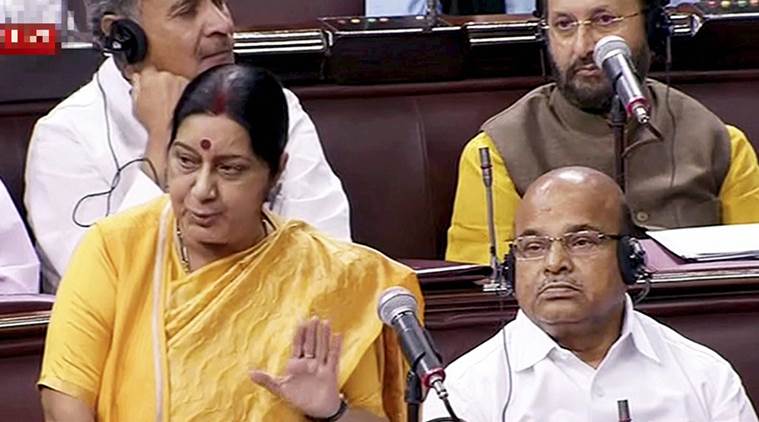Sushma Swaraj: Doklam not only issue, solution will emerge through dialogue

New Delhi: External Affairs Minister Sushma Swaraj speaks in the Rajya Sabha during the ongoing monsoon session of Parliament, in New Delhi on Thursday. PTI Photo/TV Grab(PTI8_3_2017_000014B)
New Delhi / Underlining that China has been contributing to India’s growing economic might, External Affairs Minister Sushma Swaraj Thursday said dialogue is the only way out of the Doklam standoff between Indian and Chinese troops at the trijunction with Bhutan and this should be seen in the context of the “entire bilateral relationship”. She ruled out war as an option, saying a solution can only be reached through dialogue.
Speaking in Rajya Sabha, where she was replying to a discussion on India’s foreign policy, Swaraj said: “Hamari jo aarthik kshamta badh rahi hai, usme China ka yogdaan hai… unka yahan bahut zyada risk, stake hai… kitne zyada contract unhe diye huye hain (China has contributed to our growing economic strength. For them, there’s a lot at stake, risk here. They have been awarded many contracts).”
Pointing out that BSP’s Satish Chandra Mishra had said that the government should negotiate with China not just on Doklam, but the entire relationship, she said, “We are not negotiating only on Doklam, we are talking about bilateral relations in entirety. And a solution will also emerge from it.” “As far as economic strength is concerned, China is one of the leading countries among major contributors and economic partners. That’s why Doklam is not the lone issue. So, a solution will definitely emerge if we engage in dialogue on bilateral relations.”
India Received 60 Billion Us Dollars Foreign Investment Last Year- Sushma Swaraj
With some members saying that the country should be ready for war, Swaraj reminded them that a standing army was there for such situations. But even after a war, she said, a solution can only be arrived at through dialogue. She called for “patience” and “restraint” in dealing with the situation, and also the need for “restraint in statements”.
On Thursday, Chinese diplomats again said that patience was running thin in the Chinese establishment. They warned of consequences if Indian troops did not vacate what they call “Chinese territory”. A senior Chinese diplomat said there were 48 Indian soldiers at Doklam — Indian officials said 350 Indian soldiers were present there. During her reply in the House, Swaraj also took a swipe at Congress vice-president Rahul Gandhi. She said he had met the Chinese ambassador in New Delhi but had not bothered to first get the Indian government’s position on the Doklam issue.
“He should have first heard the Indian government’s view, and then should have confronted the Chinese envoy with facts. Instead, he met the Chinese ambassador to get facts on Doklam,” she said, remarks that were objected to by Anand Sharma of the Congress. Later, reading from a prepared statement, Swaraj referred to a 15-page statement of the Chinese government. “The Chinese side, in their recent document published on the website of their Foreign Ministry, had expressed commitment to maintaining peace and tranquility in the India-China border areas. India always believes that peace and tranquility in the India-China border is an important pre-requisite for smooth development of our bilateral relations.”
Sikkim Impasse Explained: What Is The India-China-Bhutan Border Standoff?
“We will continue to engage with the Chinese side through diplomatic channels to find a mutually acceptable solution on the basis of the Astana Consensus between our leaders. I note the sense of the House is supportive in this regard. In keeping the traditional friendship with Bhutan, we will also continue to maintain close consultation and coordination with the Royal Government of Bhutan.”
“Our concerns emanate from Chinese action on the ground which have implications for the determination of the trijunction boundary point between India, China and Bhutan and the alignment of India-China boundary in the Sikkim sector.”
She said that both these aspects of trijunction points and India-China boundary alignment in the Sikkim sector had earlier been addressed in a written common understanding reached between the Special Representatives of India and China on the boundary question in December 2012. “Point 13 of the common understanding states that ‘The trijunction boundary points between India, China and third countries will be finalised in consultation with the concerned countries. Since 2012, we have not held any discussion on the trijunction with Bhutan. The Chinese action in the Doklam area is therefore of concern,” she said.
Swaraj also said: “We have noted that the Chinese side has selectively quoted parts of Prime Minister Jawaharlal Nehru’s letter of 22nd March, 1959 pertaining to the India-China boundary in the Sikkim sector. A full and accurate account of that letter would have also brought out Prime Minister Nehru’s assertion that was clearly based on the boundary alignment as shown in our Indian published maps,” she said.